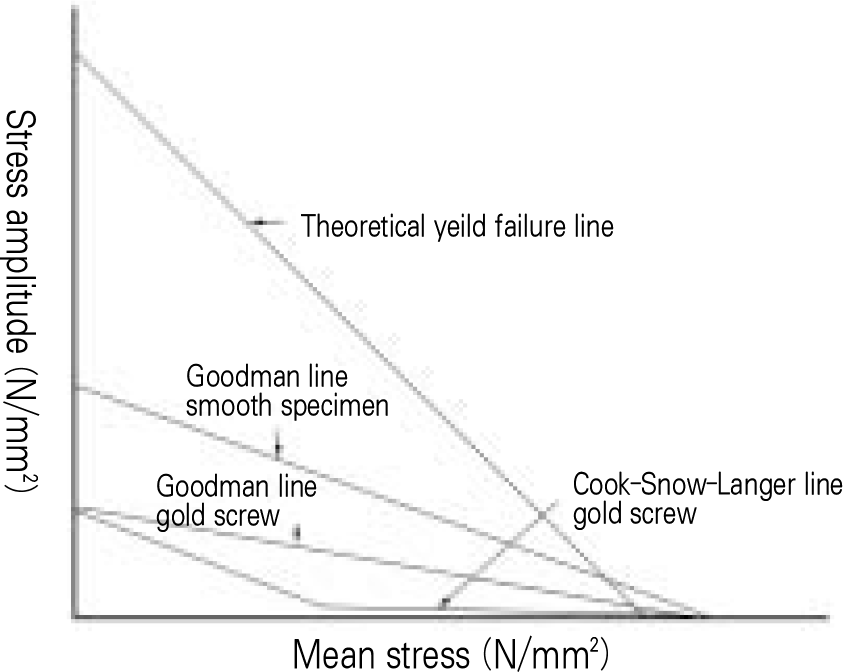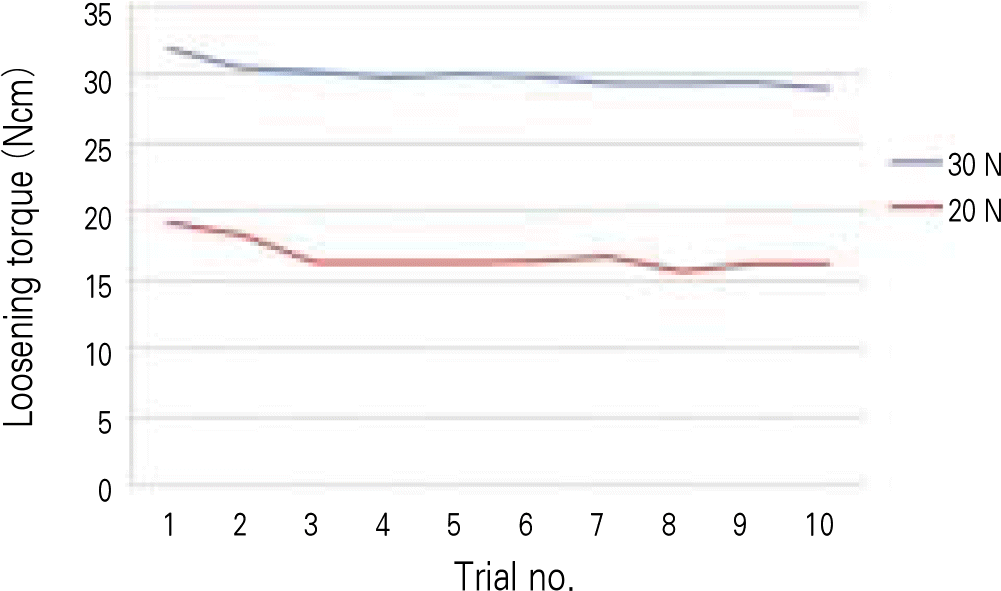Abstract
Methods
Available clinical studies from 1981 to 2008 from the PUBMED that presented screw loosening data and review articles regarding screw joint stability were evaluated. Eleven studies dealing the biomechanical principles of the screw mechanics were reviewed. Moreover, the results of our data were included.
Results
The frequency of screw loosening was consequently reduced due to the advancement in torque tightening with torque wrench, screw material, coating technique for reducing the frictional force, and thread design, etc. If preload in the screw falls below a critical level, joint stability may be compromised, and the screw joint may fail clinically. The types of fatigue failure of screw were divided to adhesive wear, plastic deformation, and screw fracture.
Go to : 
REFERENCES
1.McGlumphy EA., Mendel DA., Holloway JA. Implant screw mechanics. Dent Clin North Am. 1998. 42:71–89.
2.Jung RE., Pjetursson BE., Glauser R., Zembic A., Zwahlen M., Lang NP. A systematic review of the 5-year survival and complication rates of implant-supported single crowns. Clin Oral Implants Res. 2008. 19:119–30.

3.Jemt T., Laney WR., Harris D., Henry PJ., Krogh PH Jr., Polizzi G., Zarb GA., Herrmann I. Osseointegrated implants for single tooth replacement: a 1-year report from a multicenter prospective study. Int J Oral Maxillofac Implants. 1991. 6:29–36.
4.Jemt T., Pettersson P. A 3-year follow-up study on single implant treatment. J Dent. 1993. 21:203–8.

5.Laney WR., Jemt T., Harris D., Henry PJ., Krogh PH., Polizzi G., Zarb GA., Herrmann I. Osseointegrated implants for single-tooth replacement: progress report from a multicenter prospective study after 3 years. Int J Oral Maxillofac Implants. 1994. 9:49–54.
6.Henry PJ., Laney WR., Jemt T., Harris D., Krogh PH., Polizzi G., Zarb GA., Herrmann I. Osseointegrated implants for single-tooth replacement: a prospective 5-year multicenter study. Int J Oral Maxillofac Implants. 1996. 11:450–5.
7.Priest G. Single-tooth implants and their role in preserving remaining teeth: a 10-year survival study. Int J Oral Maxillofac Implants. 1999. 14:181–8.
8.Lang LA., Kang B., Wang RF., Lang BR. Finite element analysis to determine implant preload. J Prosthet Dent. 2003. 90:539–46.

9.Patterson EA., Johns RB. Theoretical analysis of the fatigue life of fixture screws in osseointegrated dental implants. Int J Oral Maxillofac Implants. 1992. 7:26–33.
10.Jaarda MJ., Razzoog ME., Gratton DG. Effect of preload torque on the ultimate tensile strength of implant prosthetic retaining screws. Implant Dent. 1994. 3:17–21.

11.Mitrani R., Nicholls JI., Phillips KM., Ma T. Accuracy of electronic implant torque controllers following time in clinical service. Int J Oral Maxillofac Implants. 2001. 16:394–9.
12.Gutierrez J., Nicholls JI., Libman WJ., Butson TJ. Accuracy of the implant torque wrench following time in clinical service. Int J Prosthodont. 1997. 10:562–7.
13.Kim DG., Park CJ., Cho LR. Comparison of accuracy of implant torque controllers. J Kor Acad Stomatognathic Func and Occl. 2008. 24:157–68.
14.Dellinges M., Curtis D. Effects of infection control procedures on the accuracy of a new mechanical torque wrench system for implant restorations. J Prosthet Dent. 1996. 75:93–8.

15.Haack JE., Sakaguchi RL., Sun T., Coffey JP. Elongation and preload stress in dental implant abutment screws. Int J Oral Maxillofac Implants. 1995. 10:529–36.
16.Jo ¨rne ′us L., Jemt T., Carlsson L. Loads and designs of screw joints for single crowns supported by osseointegrated implants. Int J Oral Maxillofac Implants. 1992. 7:353–9.
17.Theoharidou A., Petridis HP., Tzannas K., Garefis P. Abutment screw loosening in single-implant restorations: a systematic review. Int J Oral Maxillofac Implants. 2008. 23:681–90.
18.Kang YM., Lim JH., Cho IH. A study on the abutment screw loosening of dental implants. J Korean Acad Prosthodont. 1996. 34:1–14.
19.Al Jabbari YS., Fournelle R., Ziebert G., Toth J., Iacopino AM. Mechanical behavior and failure analysis of prosthetic retaining screws after long-term use in vivo. Part 1: Characterization of adhesive wear and structure of retaining screws. J Prosthodont. 2008. 17:168–80.

20.Misch CE. The effect of bruxism on treatment planning for dental implants. Dent Today. 2002. 21:76–81.
21.Khraisat A., Hashimoto A., Nomura S., Miyakawa O. Effect of lateral cyclic loading on abutment screw loosening of an external hexagon implant system. J Prosthet Dent. 2004. 91:326–34.

22.Lang LA., Wang RF., May KB. The influence of abutment screw tightening on screw joint configuration. J Prosthet Dent. 2002. 87:74–9.

Go to : 
 | Fig. 1.Clinical images and SEM images of fractured screws. Arrow indicates the starting point of crack line. |
 | Fig. 2.Marginal bone loss around the fractured abutment screw. From first fracture, the other fractures were consequently happened (Fig. 1). |
 | Fig. 3.Estimation of fatigue life of gold screw; theoretical failure and realistic failure. |
 | Fig. 4.A, Electronic torque controller; B, Torque limiting device; C, Torque indicating device; D, Contra-angle torque device. |
 | Fig. 6.Mechanical tolerance of various implants. A, Implantium (Dentium, Seoul, Korea); B, Astra (Astratech, Mo ¨lndal, Sweden); C, GS (Osstem, Pusan, Korea); D, M implant (Shinhung, Seoul, Korea). |
 | Fig. 8.Schematic diagram of the mechanism of adhesive wear of screws in implant prostheses. (Upper thread indicates much milder state, while lower thread indicates much severe state of wear). |
Table I.
Screw loosening in single implant prosthesis
Table II.
Multiple factors for screw loosening




 PDF
PDF ePub
ePub Citation
Citation Print
Print




 XML Download
XML Download